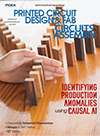News
News
REACH Costs ‘Horrifically Expensive’
Published: 25 September 2008
by Staff
 Talking HeadsThe legislation known as REACH (Regulation on Registration, Evaluation, Authorisation and Restriction of Chemicals) has been in effect since June 1, 2007, yet that particular date lacked impact, says Michael Kirschner. The president of Design Chain Associates (designchainassociates.com), who has spent the last several years tracking the various environmental legislations around the globe, says Dec. 1 is the GO date. He spoke about the status of REACH legislation with Circuits Assembly senior editor Chelsey Drysdale in September.
Talking HeadsThe legislation known as REACH (Regulation on Registration, Evaluation, Authorisation and Restriction of Chemicals) has been in effect since June 1, 2007, yet that particular date lacked impact, says Michael Kirschner. The president of Design Chain Associates (designchainassociates.com), who has spent the last several years tracking the various environmental legislations around the globe, says Dec. 1 is the GO date. He spoke about the status of REACH legislation with Circuits Assembly senior editor Chelsey Drysdale in September.CA: What is going on with REACH enforcement?
MK: Although REACH has been in effect since June 1, 2007, enforcement didn’t begin then because the deadline did not involve mainstream issues; it was for actions such as revising safety data. But between June 1 and Dec. 1, companies that manufacture or import substances in an amount greater than one metric ton per year should pre-register substances to take advantage of the extended timelines. (Otherwise, manufacturers will have to register products before their next shipment after Dec. 1.)
CA: What’s the situation with the extended timelines?
MK: Extended timelines involve the highest volume of chemicals, which must be registered sometime in 2010. The next level of chemicals has to be registered by 2013. The last deadline is 2018. Right now, chemicals that will be registered under REACH legislation are estimated at 30,000. Many firms fail to understand the regulation. They don’t think they use chemical substances, so they don’t think the regulation is applicable to them. But, everything has chemicals.
CA: According to a recent IPC survey, the industry isn’t ready for REACH. What do you think about the findings?
MK: The industry is really behind the curve in terms of understanding. It extends from small- to medium-sized companies to the biggest of the big. On the other hand, some large OEMs understand it correctly and are beginning to push suppliers for information.
REACH substances don’t overlap with RoHS substances. Many companies have no idea if these substances are in their products. A few have started asking supply chains. A wise few have received full material disclosure and are starting to answer questions. The rest of the industry may not be ready.
CA: So what should companies be doing right now?
MK: The issue that must be dealt with immediately and for the next decade is that of substances of very high concern. There is a proposed list of 16 substances of very high concern. The list has gone through the stakeholder input process and will most likely be published in the second half of October. It hopefully will be reduced to a smaller number.
Once the list is published, companies will have two responsibilities: They must immediately disclose to customers products that contain 0.1% by weight of those high-concern substances. This includes anything from lead frame to PCB to power supply to computer rack of equipment – anything but substances in preparations.
Then, consumers (a word that isn’t defined by REACH) – basically everybody and anybody – will be able to start asking companies if their products contain any of these substances. And the companies must respond in 45 days.
The European chemical agency has another stakeholder comment period through April during which they will say, “this is the list of candidates of very high concern.” Then they will submit the list to the European Commission for authorization – or restriction. That submission date will be in early June.
Then the commission will start the whole process again to determine exemptions and restrictions. There will be new proposed candidate lists for very high concern substances as often as twice a year. The law has a 10-year horizon.
CA: What are some of the risks involved?
MK: The biggest risk is the risk of consumer advocates such as the World Wildlife Fund, Greenpeace and others asking consumer electronics companies if their products include these chemicals. They are champing at the bit. They already published a form letter a year ago to show how to ask. It will be interesting to see what happens. Enforcement agencies ultimately could go after and publish the names of offenders.
CA: I’m assuming the costs will be high.
MK: Costs eventually will be horrifically expensive. There is the potential for restricting dozens if not hundreds of chemicals over the next decade in the electronics industry. If the industry reactively approaches each substance one by one, costs will be really high. The industry has historically taken the reactive approach. It won’t be handled proficiently. The industry needs to think proactively.
Press Releases
- Trilogy-NET Adds Second Vapor Phase Reflow System to Expand High-Precision Manufacturing
- Federal Electronics Invests in HydroJet Inline Cleaning Technology at Hermosillo Facility
- Seika Machinery to Host Webinar on Wireless Strain Measurement for PCB Testing
- NEPCON ASIA 2025: Innovating Smart Manufacturing Ecosystems and Bridging Global Opportunities







